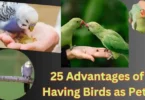We provide the most comprehensive and reliable information to ensure the well-being of your beloved pets. This guide delves into the crucial topic of love bird cage size. Offering expert insights to help you create a habitat that promotes the health and happiness of your feathered friends.
Understanding the Significance of Love Bird Cage Size
Selecting the right cage size for your lovebirds is an essential responsibility for any caring pet owner. Having the right size cage is important because it gives your birds room to move and also affects how they feel and their overall health.
Love Bird Cage Size: Ideal Cage Dimensions
To ensure your lovebirds’ comfort and well-being, we recommend the following love bird cage size dimensions:
- Width: A minimum of 24 inches provides ample room for your lovebirds to spread their wings and move freely.
- Height: Opt for a cage that is at least 24 inches tall, allowing your birds to climb and explore vertically.
- Depth: A cage with a depth of 18 inches or more ensures there is sufficient space for perches, toys, and feeding stations.
Love bird cage size chart
| Aspect | Minimum Dimensions | Accommodates |
| Width | 24 inches | Multiple lovebirds |
| Height | 24 inches | Multiple lovebirds |
| Depth | 18 inches or more | Perches, toys, feeding stations |
Creating a Stimulating Environment: Love Bird Cage Size

A well-sized cage is only the first step; designing the interior is equally important. Here’s how you can create a stimulating environment for your lovebirds:
Perches and Branches: Incorporate a variety of perch sizes and materials to encourage foot health and provide exercise. Branches with varying diameters simulate the natural habitat of lovebirds.
Toys and Entertainment: Keep your lovebirds mentally engaged by providing a range of toys, such as puzzle toys, bells, and swings. Rotating toys frequently prevents boredom.
Feeding Stations: Dedicate specific areas within the cage for food and water. Stainless steel bowls are recommended, as they are easy to clean and durable.
Nesting and Privacy: If you plan on breeding lovebirds, include a nest box in the cage. Ensure the nest box is appropriately sized and placed in a quiet, secluded corner of the cell.
Love Bird Cage Location
Selecting the right location for the cage is important for the well-being of your lovebirds. Here are some considerations:
- Avoid Drafts: Keep the cage away from drafts and open windows to prevent temperature fluctuations that could stress your birds.
- Social Interaction: Place the cage in a common area of your home where the birds can be part of family activities, which will help them feel less isolated.
- Quiet and Safe: Ensure the cage is in a quiet area to prevent excessive noise or disturbances that could stress them. Also, make sure the cage is safe from other pets or potential hazards.
Importance of Sunlight
Lovebirds need exposure to natural sunlight or full-spectrum UV lighting for at least 2-4 hours a day. Sunlight provides them with vitamin D3, which is essential for calcium metabolism and overall health. If natural sunlight isn’t possible, consider providing artificial UV lighting designed for birds.
Safety First
Safety is paramount for your lovebirds:
- Cage Bars: Ensure the cage bars are appropriately spaced so that your lovebirds cannot escape or get their heads stuck between the bars.
- Non-Toxic Materials: Use cage furnishings and toys made from bird-safe materials. Avoid items with lead or zinc, as these can be toxic to birds.
- Secure Locks: Ensure the cage has secure locks to prevent accidental escapes.
- No Toxic Plants: Remove any toxic plants from the vicinity of the cage, as lovebirds may chew on them.
Furnishing the Cage: How to Setup Lovebirds Cage
To create a stimulating and comfortable environment for your lovebirds, consider the following:
- Perches: Provide various types of perches of different diameters and materials to encourage foot exercise.
- Toys: Offer a variety of toys, such as swings, bells, and puzzles, to keep them mentally and physically active.
- Food and Water: Place food and water dishes in a convenient location within the cage.
- Bedding: Line the cage with appropriate bedding material, like newspaper or bird-safe bedding, and change it regularly.
- Hideaways: Include shelters or nest boxes for your lovebirds to retreat to when they need privacy.
Remember that lovebirds are highly social and thrive on interaction with their owners and companionship with other birds. Consider getting a pair of lovebirds rather than keeping a single bird to prevent loneliness.
Regularly clean the cage and provide fresh food and water daily. By paying attention to these aspects of lovebird care, you can ensure a safe and enjoyable environment for your feathered friends.
Love Bird Cage: Maintenance and Care
Maintaining a clean and hygienic cage is vital for your lovebirds’ health. Regularly clean the cage, perches, toys, and feeding bowls to prevent the buildup of bacteria. Place the cage in an area free from drafts and direct sunlight to provide a comfortable and safe environment.
Conclusion
Choosing the right cage size for your lovebirds is a critical decision that directly impacts their quality of life.
When you ensure your pet birds have lots of room to move around and interesting things to do, they will be happy and stay in good shape. At PetsCareWorld, we really want to help you take good care of your pets. We believe this guide will help you make a great home for your feathered friends that you love.
Don’t forget, each bird is different. So, pay attention to how they act and what they like. This will help you change their living space to make them feel their best.
Frequently Asked Questions (FAQs)
Why is the size of the cage important for lovebirds?
The size of the cage directly impacts the well-being of your lovebirds. A spacious cage allows them to move around, stretch their wings, and engage in natural behaviors. It also provides room for perches, toys, and feeding stations, promoting physical and mental health.
What are the recommended dimensions for a lovebird cage?
For a single pair of lovebirds, we recommend a cage with a width of at least 24 inches, a height of 24 inches, and a depth of 18 inches. For multiple lovebirds, consider a cage with dimensions of approximately 36 inches in width, 36 inches in height, and 24 inches in depth.
Can I use a smaller cage if my lovebirds have ample out-of-cage time?
While out-of-cage time is beneficial, it doesn’t replace the need for an appropriately sized cage. Lovebirds should have a spacious cage to ensure their comfort and safety even when they are inside.
How do I set up the interior of the cage for optimal enrichment?
Make the surroundings interesting by having different sizes of perches and materials. Give them various toys to keep their minds active. Have specific places for them to eat, and if you’re planning for them to have babies, make sure there’s a private spot for them to nest.
Is it necessary to have a nest box in the cage?
A nest box is recommended if you plan on breeding lovebirds. However, make sure the cage remains spacious even with the addition of a nest box, as overcrowding can lead to stress and territorial issues.
How often should I clean the cage?
Regular cleaning is crucial to maintain your lovebirds’ health. Clean the cage, perches, toys, and feeding bowls at least once a week. Remove uneaten food promptly to prevent bacterial growth.
Can I place the cage near a window or in direct sunlight?
It’s best to avoid placing the cage near windows, as direct sunlight and drafts can be harmful to lovebirds. Choose a quiet and well-ventilated area, away from extreme temperature fluctuations.
What materials should I avoid when choosing a cage?
Avoid cages with toxic materials such as lead or zinc. Opt for cages made from bird-safe materials like stainless steel or powder-coated metal.
How do I know if my lovebirds are comfortable in their cage?
Observing your lovebirds’ behavior is key. If they move around freely, play with toys, and have a calm demeanor, it’s a sign that they are comfortable. If they appear stressed, agitated, or exhibit aggressive behavior, consider adjusting the cage size or setup.
Where can I find more information and resources about Lovebird Care?
For more in-depth information and personalized guidance on love bird’s care, feel free to reach out to us at PetsCareWorld. Additionally, you can explore reputable avian care books, online forums, and bird care associations.







Leave a Comment
You must be logged in to post a comment.